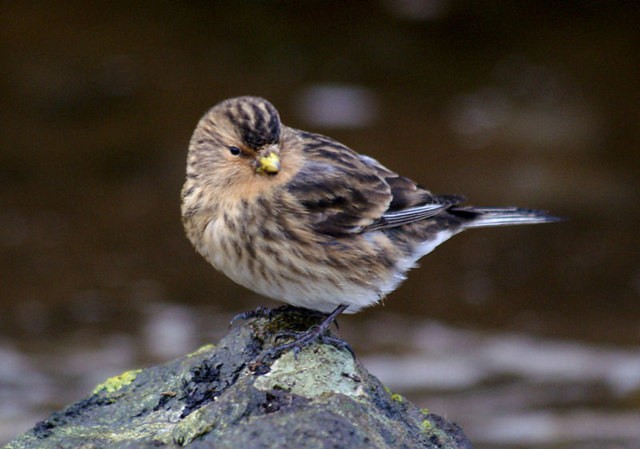Twite
A species of Linnets and Twite Scientific name : Linaria flavirostris Genus : Linnets and Twite
Twite, A species of Linnets and Twite
Botanical name: Linaria flavirostris
Genus: Linnets and Twite
Content
Description General Info
 Photo By Mike Pennington , used under CC-BY-SA-2.0 /Cropped and compressed from original
Photo By Mike Pennington , used under CC-BY-SA-2.0 /Cropped and compressed from original Description
The twite (Linaria flavirostris) is a small brown passerine bird in the finch family Fringillidae. It is similar in size and shape to a linnet, at 13 to 13.5 centimetres (5.1 to 5.3 in) long. It lacks the red head patch and breast shown by the linnet and the redpolls. It is brown streaked with black above, and a pink rump. The underparts are buff to whitish, streaked with brown. The conical bill is yellow in winter and grey in summer. The call is a distinctive twit, from which its name derives, and the song contains fast trills and twitters. Twites can form large flocks outside the breeding season, sometimes mixed with other finches on coasts and salt marshes. They feed mainly on seeds. The twite breeds in northern Europe and across the Palearctic to Siberia and China. Treeless moorland is favoured for breeding. It builds its nest in a bush, laying 5–6 light blue eggs. It is partially resident, but many birds migrate further south, or move to the coasts. It has declined sharply in parts of its range, notably in Ireland. In the UK, the twite is the subject of several research projects in the Pennines, the Scottish Highlands and the North Wales and Lancashire coastlines. Records show that the birds to the east of the Pennine hills move to the southeast coast in winter and those to the west winter between Lancashire and the Hebrides. The Welsh population winters almost exclusively in Flintshire. Ringing data has revealed that Twite breeding in different parts of Britain use different non‐breeding areas, and that non-breeding areas of British Twite do not overlap with non-breeding areas of continental Twite. 
Size
14 cm
Colors
Brown
Black
Yellow
Bronze
Gray
White
Life Expectancy
6 years
Nest Placement
Shrub
Feeding Habits
Twite, a seed specialist, forages primarily on small seeds, employing a ground-feeding strategy. It showcases a dietary preference for seed heads of grasses and plants, with unique adaptions to glean minute seeds efficiently.
Habitat
Twite's habitat spans open and often elevated terrains, favoring treeless moorlands and shrubs for breeding up to 750m in elevation. Throughout central and western Asia, they nest at higher altitudes, reaching 4900m, in environments like barren hillsides and alpine meadows. In winter, twite descends to lower grounds, utilizing open pastures, river valleys, and coastal saltmarshes, avoiding urban areas in favor of natural landscapes.
Dite type
Granivorous
General Info
Feeding Habits
Bird food type
Species Status
Not globally threatened.
Scientific Classification
Phylum
Chordates Class
Birds Order
Perching birds Family
Finches Genus
Linnets and Twite Species
Twite